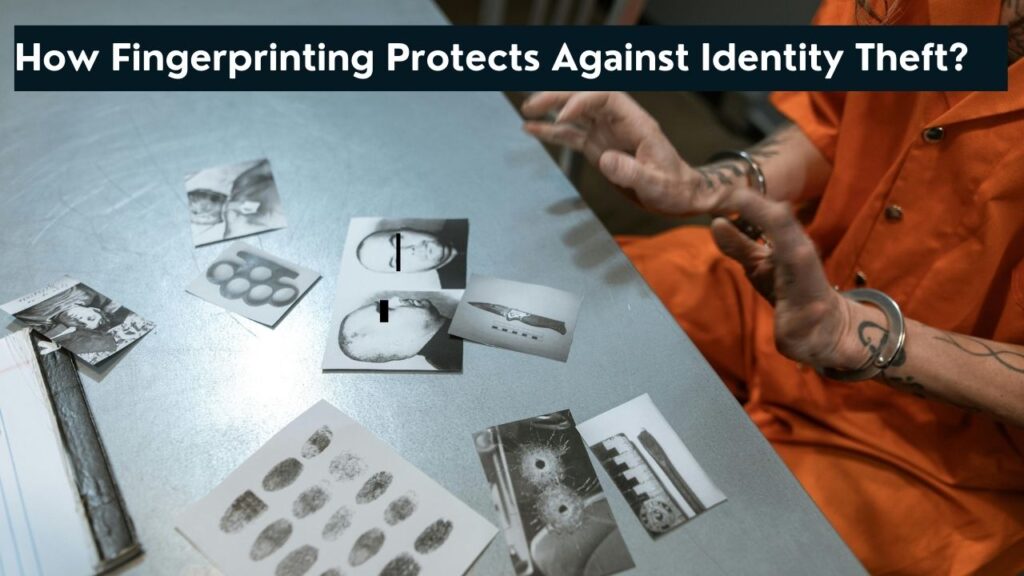In today’s digital age, identity theft is an ever-growing concern. The increasing reliance on online transactions, social media, and electronic communication has made personal data more vulnerable than ever. As a result, the need for robust security measures is critical. One such measure that has gained prominence is fingerprinting. Known for its accuracy and uniqueness, fingerprinting has become a powerful tool in the fight against identity theft. This article will delve into the mechanics of fingerprinting, how it works, and how it serves as a defense against identity theft.
Understanding Identity Theft
Before diving into how fingerprinting protects against identity theft, it’s crucial to understand what identity theft is. Identity theft occurs when someone illegally obtains and uses another person’s personal information—such as their name, Social Security number, or credit card details—without permission. The goal is typically financial gain, but it can also lead to other forms of fraud, including medical, criminal, and synthetic identity theft. The impact of identity theft can be devastating, leading to financial loss, damaged credit, and significant emotional distress.
For businesses looking to secure their operations and protect against identity fraud, implementing FBI fingerprinting services for businesses is an essential step, offering robust security measures that align with federal requirements.
The Rise of Biometric Security
Biometrics refers to the measurement and statistical analysis of people’s unique physical and behavioral characteristics. Among the various types of biometrics, such as facial recognition, voice recognition, and iris scanning, fingerprinting is one of the most widely used and trusted methods. Fingerprinting has been used for decades, primarily in law enforcement, to identify individuals uniquely and accurately. Its reliability has paved the way for its adoption in other sectors, including banking, healthcare, and mobile technology, to enhance security and prevent unauthorized access.
How Fingerprinting Works
Fingerprinting involves capturing the unique patterns of ridges and valleys on an individual’s finger. No two fingerprints are alike, even among identical twins, making this method highly secure. Here’s a brief overview of how fingerprinting technology works:
- Fingerprint Capture: The process begins with capturing an image of the fingerprint using a fingerprint scanner. The scanner can be optical, capacitive, or ultrasonic, each using different techniques to capture the fingerprint.
- Feature Extraction: Once the fingerprint is captured, the system identifies specific features within the print, such as minutiae points (where ridges end or bifurcate) and ridge patterns. These features are converted into a digital format.
- Template Creation: The extracted features are then compiled into a fingerprint template, a digital representation of the fingerprint. This template is unique to the individual and is used for future comparisons.
- Comparison and Matching: When an individual attempts to authenticate their identity, their fingerprint is captured again and compared to the stored template. If the two templates match, the identity is verified.
To ensure the highest level of accuracy and security in identity verification, Live Scan fingerprinting services are pivotal, providing electronic fingerprinting that significantly reduces the risk of identity theft.
Fingerprinting as a Defense Against Identity Theft
Fingerprinting offers several advantages in protecting against identity theft, making it a formidable defense mechanism.
1. Uniqueness and Accuracy
The uniqueness of fingerprints is the cornerstone of their effectiveness in identity verification. Since no two individuals have the same fingerprints, the chances of false positives—where someone is incorrectly identified as another person—are incredibly low. This accuracy is critical in preventing identity thieves from impersonating others.
2. Non-Transferable Security
Unlike passwords, PINs, or security questions, fingerprints cannot be easily shared, stolen, or guessed. They are an intrinsic part of an individual’s identity. This non-transferability makes fingerprinting an effective measure against identity theft, as it eliminates the risk associated with stolen credentials.
3. Dual-Factor Authentication
Fingerprinting is often used in conjunction with other security measures, such as passwords or facial recognition, to create a dual-factor authentication (DFA) system. This layered approach adds an extra level of security. Even if a thief manages to obtain a victim’s password, they would still need the victim’s fingerprint to gain access, significantly reducing the likelihood of successful identity theft.
4. Real-Time Verification
Fingerprinting allows for real-time identity verification, which is particularly useful in high-security environments like banking or government facilities. By verifying an individual’s identity on the spot, organizations can prevent unauthorized access before it occurs, rather than dealing with the consequences after the fact.
5. Reduced Dependency on Passwords
The increasing prevalence of fingerprinting has led to a reduced dependency on passwords, which are often the weakest link in the security chain. Passwords can be stolen, guessed, or cracked, leading to identity theft. Fingerprinting, however, provides a more secure alternative that doesn’t rely on easily compromised data.
When it comes to stringent regulatory compliance and preventing identity theft, ATF fingerprinting services are crucial, particularly for individuals and businesses involved in firearms and explosives.
Applications of Fingerprinting in Identity Protection
Fingerprinting is utilized across various industries and scenarios to protect against identity theft. Here are some notable applications:
1. Financial Services
Banks and financial institutions are prime targets for identity thieves. Fingerprinting is used to enhance the security of online banking, ATMs, and mobile banking apps. Customers can use their fingerprints to authenticate transactions, ensuring that only authorized individuals can access their accounts.
2. Mobile Devices
Smartphones and tablets have become central to our daily lives, storing a wealth of personal information. Fingerprint sensors on these devices provide a convenient and secure way to unlock them, authorize payments, and access sensitive apps. This technology helps prevent unauthorized users from gaining access to personal data.
3. Government and Law Enforcement
Government agencies and law enforcement have long relied on fingerprinting for identity verification. In addition to its traditional use in criminal investigations, fingerprinting is now used in various forms of identification, such as passports, visas, and national ID cards. This ensures that individuals are accurately identified and reduces the risk of fraudulent identities being used.
4. Healthcare
Identity theft in healthcare can lead to fraudulent medical claims and compromised patient records. Fingerprinting helps ensure that patients are correctly identified before receiving medical services, protecting both the patient and the healthcare provider from fraud. It also secures access to electronic health records, ensuring that only authorized personnel can view sensitive information.
5. Workplace Security
Many companies use fingerprinting to control access to secure areas and systems within the workplace. Employees’ fingerprints can be used to unlock doors, log into computers, or access sensitive information. This not only enhances security but also provides a reliable audit trail of who accessed what and when.
Challenges and Considerations
While fingerprinting is a powerful tool in the fight against identity theft, it is not without challenges. Here are some considerations:
1. Privacy Concerns
The collection and storage of biometric data raise privacy concerns. If fingerprint data is not securely stored or is improperly handled, it could be compromised, leading to potential misuse. Organizations must implement strict data protection measures to ensure the privacy and security of biometric information.
2. False Positives and Negatives
Although rare, there is a small risk of false positives (where an unauthorized user is mistakenly recognized) or false negatives (where an authorized user is not recognized). These errors can occur due to poor-quality fingerprint scans, changes in the skin’s condition, or limitations in the fingerprinting technology.
3. Accessibility Issues
Not everyone can provide usable fingerprints. Some individuals, such as those with certain disabilities or medical conditions, may have difficulty using fingerprint scanners. In such cases, alternative authentication methods need to be available.
4. Technological Limitations
While fingerprinting technology has advanced significantly, it is still subject to limitations. For instance, fingerprint scanners may not work as effectively in harsh environments or with dirty or wet hands. Additionally, sophisticated criminals may attempt to spoof fingerprint scanners using fake fingerprints, though modern systems have measures to detect such attempts.
Future of Fingerprinting in Identity Protection
The future of fingerprinting in identity protection looks promising as technology continues to evolve. Advancements in artificial intelligence (AI) and machine learning are expected to improve the accuracy and reliability of fingerprint recognition systems, reducing the chances of errors. Moreover, as more industries adopt biometric security measures, fingerprinting will likely become even more widespread, offering enhanced protection against identity theft.
Additionally, ongoing research into multi-modal biometric systems—which combine fingerprints with other biometric identifiers like facial recognition or voice recognition—could further bolster security. These systems would make it even more difficult for identity thieves to compromise personal data, providing an additional layer of defense.
Conclusion
Fingerprinting has emerged as a vital tool in the battle against identity theft. Its uniqueness, accuracy, and ease of use make it a reliable method for verifying identity and securing personal information. While there are challenges and considerations to address, the benefits of fingerprinting in protecting against identity theft far outweigh the drawbacks. As technology advances, fingerprinting will continue to play a crucial role in safeguarding our identities in an increasingly digital world.
Frequently Asked Questions (FAQs) on Fingerprinting and Identity Theft
1. What should I do if my fingerprint data is compromised?
If your fingerprint data is compromised, immediately contact the organization that collected your biometrics. Request information on the breach and what steps they are taking to mitigate the risk. Consider using additional layers of security, such as multi-factor authentication, and be vigilant about monitoring your financial accounts for any signs of fraud.
2. How can I ensure my fingerprint data is securely stored?
When providing your fingerprint data, ensure the organization follows strict security protocols. They should use encryption to protect the data, store it on secure servers, and comply with privacy regulations like GDPR. You can also inquire about their data retention policies to know how long your biometric data will be stored.
3. What if my fingerprint scanner doesn’t recognize my fingerprint?
If your fingerprint scanner fails to recognize your fingerprint, try cleaning the scanner and your finger to remove any dirt or moisture. If the problem persists, try registering multiple fingers to your device. In cases where the scanner consistently fails, check if the scanner needs recalibration or contact technical support.
4. Can identity thieves create fake fingerprints to bypass security systems?
While it’s theoretically possible, most modern fingerprint scanners are equipped with anti-spoofing technologies that detect fake fingerprints made from materials like silicone or gelatin. To enhance security, use devices that incorporate multi-factor authentication, combining fingerprint recognition with another form of verification, such as a PIN or facial recognition.
5. What alternatives are available if I can’t use fingerprint authentication due to a disability?
If fingerprint authentication isn’t accessible to you, consider using other biometric methods like facial recognition, iris scanning, or voice recognition. Most systems that rely on biometric security offer alternative options, so you can choose the method that works best for your situation.


